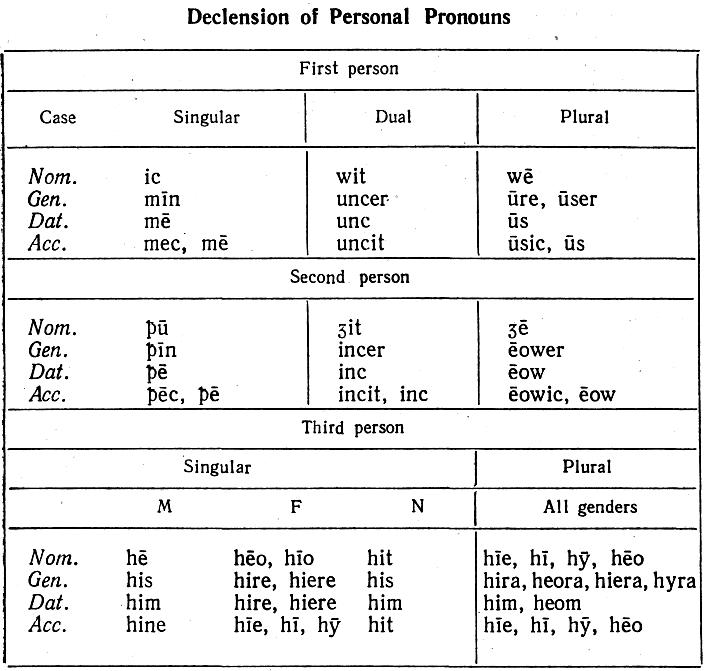
- •Lecture 8 old english grammar Plan
- •Literature
- •Preliminary remarks. Form-Building. Parts of Speech and Grammatical Categories
- •The noun Grammatical Categories. The Use of Cases
- •Morphological Classification of Nouns. Declensions
- •The pronoun
- •Personal Pronouns
- •Other Classes of Pronouns
- •The adjective Grammatical Categories
- •Weak and Strong Declension
- •Degrees of Comparison
- •The verb
- •Grammatical Categories of the Finite Verb
- •Grammatical Categories of the Verbals
- •Morphological Classification of Verbs
- •Strong Verbs
- •Weak Verbs
- •Minor Groups of Verbs
- •The Phrase. Noun, Adjective and Verb Patterns
- •Compound and Complex Sentences. Connectives
- •Word Order
The pronoun
OE pronouns fell roughly under the same main classes as modern pronouns: personal, demonstrative, interrogative and indefinite. As for the other groups – relative, possessive and reflexive – they were as yet not fully developed and were not always distinctly separated from the four main classes. The grammatical categories of the pronouns were either similar to those of nouns (in "noun-pronouns") or corresponded to those of adjectives (in "adjective pronouns"). Some features of pronouns were peculiar to them alone.
Personal Pronouns
As shown in Table 5 below, OE personal pronouns had three persons, three numbers in the 1st and 2nd p. (two numbers – in the 3rd) and three genders in the 3rd p. The pronouns of the 1st and 2nd p. had suppletive forms like their parallels in other IE languages. The pronouns of the 3rd p., having originated from demonstrative pronouns, had many affinities with the latter (cf. the forms in Table 6).
In OE, while nouns consistently distinguished between four cases, personal pronouns began to lose some of their case distinctions: the forms of the Dat. case of the pronouns of the 1st and 2nd p. were frequently used instead of the Acc.; in fact the fusion of these two cases in the pl was completed in the WS dialect already in Early OE: Acc. eowic and usic were replaced by Dat. eow, us; in the sg usage was variable, but variant forms revealed the same tendency to generalise the form of the Dat. for both cases. This is seen in the following quotation: Se pe me eh elde, se cw eð to me ‘He who healed me, he said to me’ – the first me, though Dat. in form, serves as an Acc. (direct object); the second me is a real Dat.
It is important to note that the Gen. case of personal pronouns had two main applications: like other oblique cases of noun-pronouns it could be an object, but far more frequently it was used as an attribute or a noun determiner, like a possessive pronoun, e.g. sunu mīn, his fæder (NE my, son, his, father), though forms of the Gen. case were employed as possessive pronouns, they cannot be regarded as possessive pronouns proper (that is, as a separate class of pronouns). The grammatical characteristics of these forms were not homogeneous. The forms of the 1st and 2nd p. – min, ure and others – were declined like adjectives to show agreement with the nouns they modified, while the forms of the 3rd p. behaved like nouns: they remained uninflected and did not agree with the nouns they modified.

Table 5

The oblique cases of personal pronouns in combination with the adjective self could also serve as reflexive pronouns, e. g.; возвратный,
if hwa hw et lytles eni es biwistes him selfum earcode... ‘If any one provided himself with some small portion of food...’
Demonstrative Pronouns
There were two demonstrative pronouns in OE: the prototype of NE that, which distinguished three genders in the sg and had one form for all the genders in the pl. (see Table 6) and the prototype of this with the same subdivisions: pes Masc., peos Fem., pis Neut. and pas pl. They were declined like adjectives according to a five-case system: Nom., Gen., Dat., Acc., and Instr. (the latter having a special form only in the Masc. and Neut. sg). 103
Table 6

As seen from the table, the paradigm of the demonstrative pronoun sē contained many homonymous forms. Some case endings resembled those of personal pronouns, e.g. -m – Dat. Masc. and Neut. sg and Dat. pl; the element -r- in the Dat. and Gen. sg Fem. and in the Gen. pl. These case endings, which do not occur in the noun paradigms, are often referred to as "pronominal" endings (-m, -r-, -t).
Demonstrative pronouns are of special importance for a student of OE for they were frequently used as noun determiners and through agreement with the noun, indicated its number, gender and case. The forms of the pronouns may help to define the forms of the nouns in ambiguous instances, e. g. in the phrases on p em lande, to p ere heorde ‘on that land, to that herd’ the forms of the pronouns help to differentiate gender: p em is Neut. or Masc., p ere is Fem.; both nouns are in the Dat. sg and happen to have identical endings: -e. In the following sentences the forms p et and pa help to distinguish between numbers:

